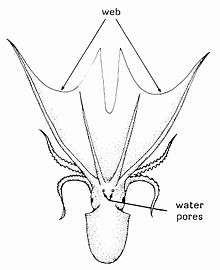Nidamental gland

Nidamental glands are internal organs found in some elasmobranchs and certain molluscs, including cephalopods (specifically Decapodiformes and nautiluses) and gastropods.[1][2][3]
In cephalopods, nidamental glands are large, paired glandular structures found in the mantle cavity.[4] Accessory nidamental glands may also be present.[4] Nidamental glands are composed of lamellae and are involved in the secretion of egg cases or the gelatinous substance comprising egg masses.[1]
Culinary uses
Nidamental glands of cuttlefish are eaten as food in various parts of the world, included either in dishes in which the whole animal is consumed, or separately. In southern Spain, for example, they are cooked whole and known as huevos de choco and there is a popular notion that these organs are the gonads of the male cuttlefish.[5]
References
- 1 2 Young, R.E., M. Vecchione & K.M. Mangold (1999). Cephalopoda Glossary. Tree of Life Web Project.
- ↑ Prasad, R.R. (1948). "Observations on the Nidamental Glands of Hydrolagus colliei, Raja rhina and Platyrhinoidis triseriatus". Copeia. 1948 (1): 54–7. doi:10.2307/1438791. JSTOR 1438791.
- ↑ Bloodgood RA (1977). "The squid accessory nidamental gland: ultrastructure and association with bacteria". Tissue Cell. 9 (2): 197–208. doi:10.1016/0040-8166(77)90016-7. PMID 906013.
- 1 2 Nair, J.R., D. Pillai, S.M. Joseph, P. Gomathi, P.V. Senan & P.M. Sherief (2011). "Cephalopod research and bioactive substances." (PDF). Indian Journal of Geo-Marine Sciences 40(1): 13–27.
- ↑ http://cocinarconciencia.blogspot.com.es/2013/02/huevos-de-choco-en-pipirrana.html


